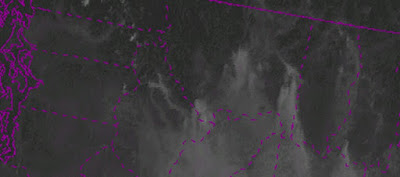On that day western Oregon and Washington was lashed by the strongest summer windstorm in its historic record.
A "perfect storm" that would bring respect during November ravaged the region, producing 40-50 mph gusts over Puget Sound, 60-70 mph gusts over NW Washington, and winds reaching 90 mph on the coast. As the center of the low passed over Tatoosh Island, on the NW tip of the Olympic Peninsula, the pressure dropped to 986 hPa....extraordinarily low for August (see graphic)
This is the lowest pressure ever observed at this location in the historical record during summer, at least for the period (1984-2008) shown below.
Nearly a half million people lost power and even today tens of thousands are without electricity in the region (see map of Seattle outages at 9 PM Sunday). Two people were killed by falling branches and several were injured. Major roads were closed due to fallen trees. Damage is certainly in the tens of millions of dollars.
Power outages over a day later in Seattle
But the most amazing thing about this storm was when it took place: the end of August.
As far as my research has shown, there has never been a summer storm even close to this one for western Washington. The most powerful summer storm EVER to hit our region. A cause for wonder and amazement. We are talking about a major midlatitude cyclone, whose winds and damage were spread over a large areas.
What is my basis for this claim?
I began by searching the most comprehensive site for major windstorm information, one created by Dr. Wolf Read. My findings: no comparable storm from May through September, in any year.
Then I went through all the coastal and buoy sites on the official NOAA site.
Nothing like it in the historical record at any of the WA coastal or NW Washington sites.
Consider Destruction Island on the WA coast. The historic maximum gust between May and September was 58 knots. Yesterday, it rose to 78 knots.
West Point in North Seattle got to 48 knots yesterday. The previous record was 38.5 knots This was not only the biggest storm, but it smashed previous records.
Yesterday we experienced a radically different animal than we have ever seen during the summer here in the Northwest.
I know some folks will say this is due to global warming, represents the "new normal", or was due to the BLOB (the warm water off our coast). At this point, there is no reason to expect that any of these hypotheses are true. Climate simulations do not produce stronger midlatitude cyclones like Saturday's. Natural variability can produce extremes and this is probably a good example. I should also note the IPCC report on extremes (IPCC is the international group evaluating the impacts of greenhouse warming), had low confidence of any connection between global warming and changes in the regional intensity of midlatitude cyclones (like the one on Saturday). A direct quote from their report Managing the Risks of Extreme Events and Disaster to Advance Climate Change Adaptation:
In summary it is likely that there has been a poleward shift in the
main Northern and Southern Hemisphere extratropical storm
tracks during the last 50 years. There is medium confidence in an
anthropogenic influence on this observed poleward shift. It has
not formally been attributed. There is low confidence in past
changes in regional intensity. There is medium confidence that
an increased anthropogenic forcing will lead to a reduction in the
number of mid-latitude cyclones averaged over each hemisphere,
and there is also medium confidence in a poleward shift of the
tropospheric storm tracks due to future anthropogenic forcings.
Regional changes may be substantial and CMIP3 simulations show
some regions with medium agreement. However, there are still
uncertainties related to how the poorly resolved stratosphere in
many CMIP3 models may influence the regional results. In addition,
studies using different analysis techniques, different physical
quantities, different thresholds, and different atmospheric vertical
levels to represent cyclone activity and storm tracks result in
different projections of regional changes. This leads to low
confidence in region-specific projections
But in the end it was perhaps fitting and expected that we had this storm. The warmest and most unusual summer in Northwest history is capped by the most severe summer windstorm in recent record. Large amounts of precipitation have quenched a dry landscape. Air quality has been restored. Many fires have been damped down. A great anomaly requires a great correction.
Yin and yang.
Something to ponder.
Announcement
If you are interested in learning about and helping the Washington State revenue-neutral carbon tax initiative, check our the CarbonWashington web site. The need signatures for the initiative and financial support. I strongly support this bipartisan effort.




















































